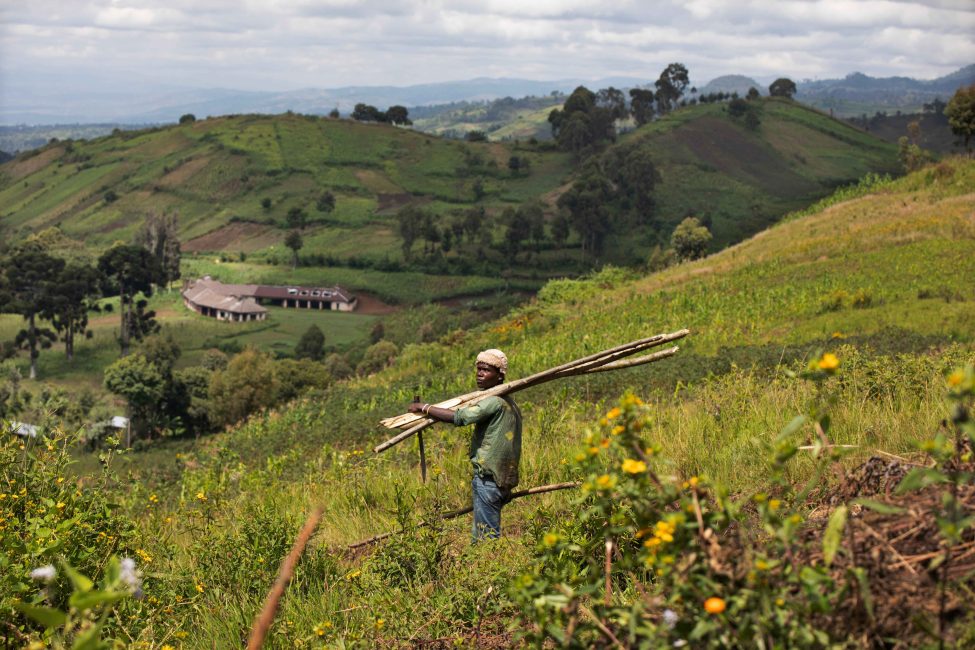“Afja moja”. One health. The facilitator and members of the local One Health committee are chanting the Swahili slogan at the top of their voices, sending it echoing around the small church in Busandwe. Hardly a year after the project bearing this name was launched, it is time for feedback on the results of the first community survey in this small village in South Kivu, a stone’s throw from Kahuzi-Biega National Park.
In this region in the eastern DRC, the risk of being infected by zoonoses is particularly high. A zoonosis is a disease that can be transmitted from animals to humans and vice versa. Among the best-known examples are the AIDS virus, Ebola and Lyme disease. About two in three infectious diseases in humans have a zoonotic origin. The pace at which these diseases are emerging has accelerated in recent decades. This is because human activity is putting increasing pressure on wildlife’s natural habitats, which leads to more and more interactions between wild animals, domestic animals and humans. All this increases the risk of transmission and creates favourable conditions for the emergence of pandemics.
One Health: hope in the face of health risks
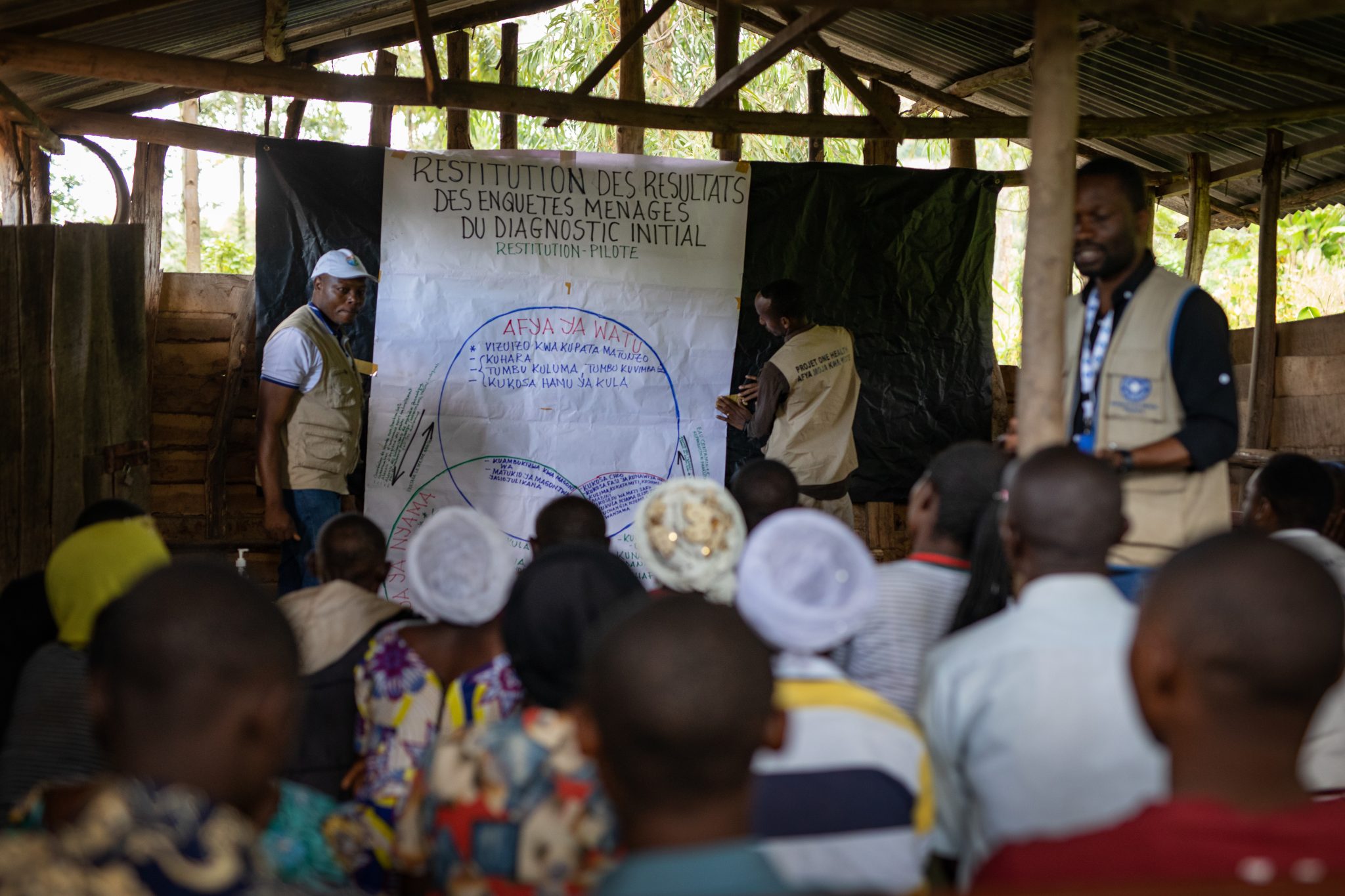
At the end of May 2023, Médecins du Monde facilitators presented the results of the participatory survey in Busandwe, near Kahuzi-Biega National Park. 282 people took part. © Thomas Cytrynowicz
To deal with these threats, the One Health approach advocates close collaboration between players involved in animal, human and environmental health. This strategy adopted by the United Nations is based on the interdependence of human and animal health and that of the ecosystems in which humans and animals live. With their respective expertise in these three aspects of health, the Belgian NGOs Vétérinaires Sans Frontières Belgium and Médecins du Monde Belgium have embarked upon a new project based on the One Health perspective with the Congolese partner Action pour le Développement des Milieux Ruraux and the communities living around Kahuzi-Biega National Park. We began by conducting a survey of local realities in order to understand them better.
The results confirm the importance of our approach: of the 282 respondents, between 60 and 80% have daily contact with animals. In the vast majority of cases, humans and animals sleep under the same roof, often due to lack of space. Pascasie Nzigiri, aged 37, confirms this: “My goats sleep in the kitchen. I prepare our food with the same pots and pans that I use to feed them.” However, goats and cows graze at the edge of the forest, where they come into contact with wild species carrying diseases, driven out of the park by deforestation and poaching. More than two in three people also report regularly eating animals found dead, without knowing the cause of their death.
This shows the magnitude of the task facing our teams, whose goal includes eliminating these practices that endanger their health. This is all the more challenging because the population is often not aware of the risks to which they are exposed: “For them, living with animals is the norm and they think it’s healthy”, says Vincent de Paul Sanvura, the manager of the One Health project for Vétérinaires Sans Frontières Belgium. For the indigenous peoples who live in the park and originate from there, it goes even further: “They believe that anything that comes from the forest is sacred and therefore cannot be bad. As they see it, diseases cannot come from there. On the contrary, what they find in the forest serves as medicine.”
Kahuzi-Biega National Park, a “hotspot for the emergence of pandemics”
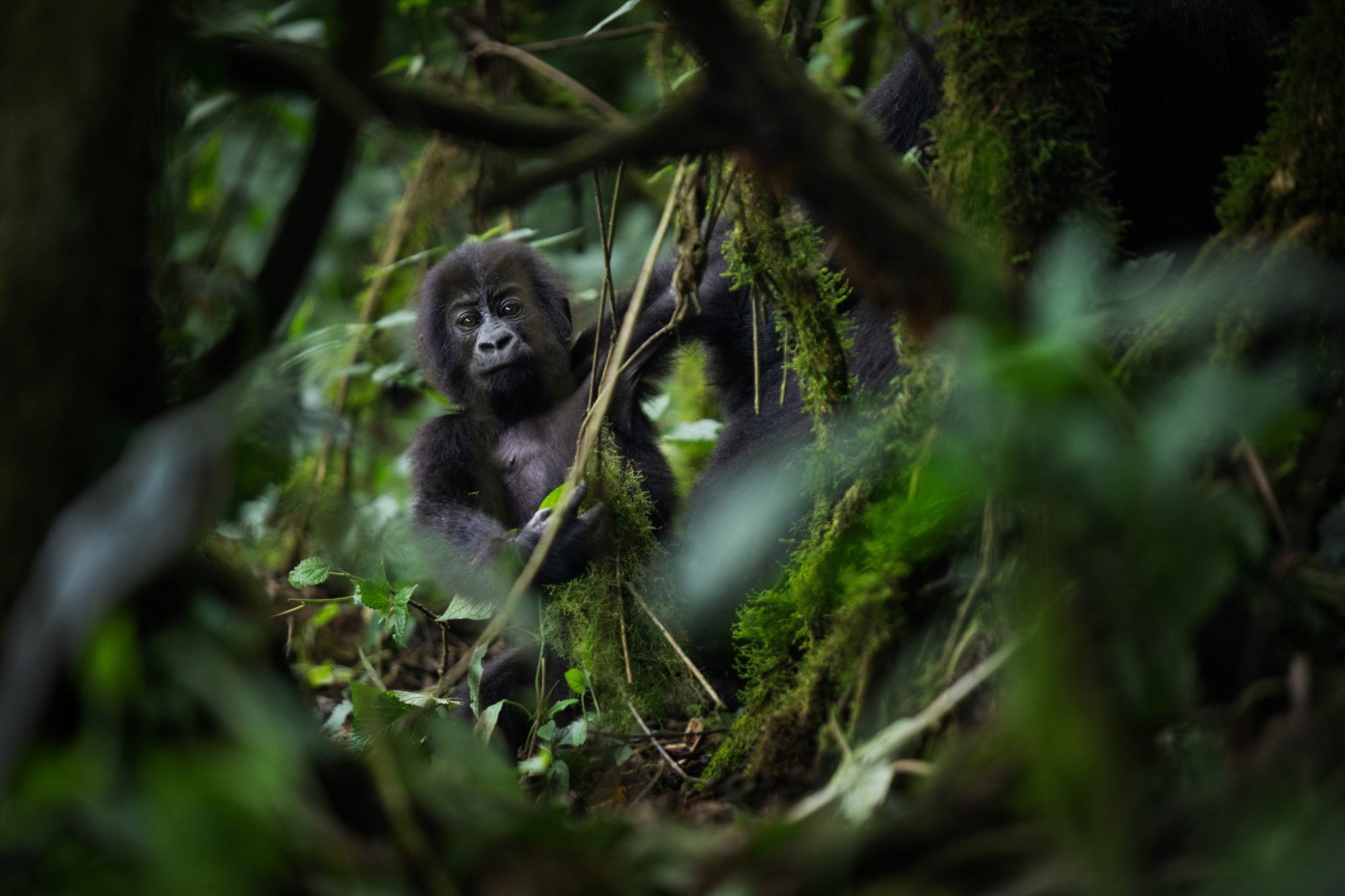
Kahuzi-Biega National Park, in South Kivu, is home to an enormous variety of fauna, including the last eastern lowland gorillas. Because of human activity in the park, these animals come into contact with livestock and people and can transmit diseases to them. © Thomas Cytrynowicz
Located in the east of the Democratic Republic of Congo, Kahuzi-Biega National Park covers 600,000 hectares between South Kivu, North Kivu and Maniema. This green lung is home to thousands of species of mammals, birds, reptiles, primates and rodents, many of them endemic to the region. It is also the last refuge of the eastern lowland gorillas.
But behind this idyllic image lies a much more threatening reality. In the words of Dr Luis Florès, a vet and researcher at the Natural Sciences Research Centre in Lwiro, on the edge of the park, it is nothing short of a “hotspot for the emergence of pandemics”. “The eastern sector of Tshivanga (the area of the park around which the project takes place – Ed.) is 35 kilometres from Bukavu and close to Goma, with its international airport. From there, a virus can quickly spread all around the world. It is no coincidence that Ebola emerged in North Kivu, another province in which part of the park is located”, explains the scientist.
Coronavirus, hantavirus, filovirus… There is no shortage of hypotheses about the next epidemic that might emerge around the Kahuzi-Biega Mountains. But according to Dr Flores, the bacteria we already know of, such as those responsible for tuberculosis, are the ones we should fear most. “These bacteria may develop resistant strains for which there is no cure”, the scientist warns. This threatens us as far away as Europe.”
When vulnerability puts pressure on the park… and threatens everyone’s health
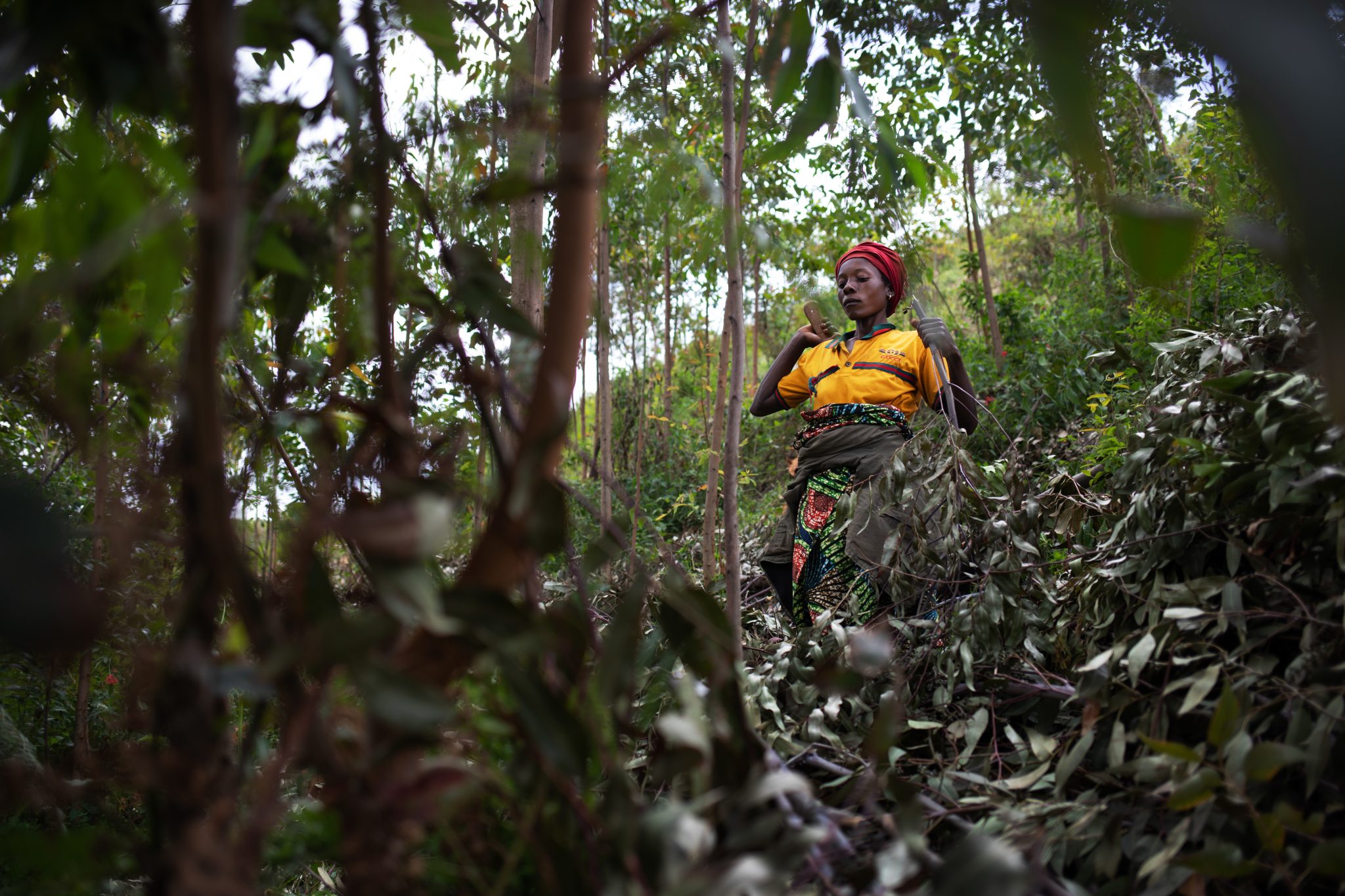
The people who live around the Kahuzi-Biega National Park are very vulnerable. They contribute to deforestation by cutting timber to meet their needs. Without knowing it, they are exposing themselves to zoonotic diseases. © Thomas Cytrynowicz
The danger is all the greater as there is no buffer zone between the park and the inhabited areas. Consequently, the people who live nearby are in constant interaction with the park and its wildlife, although this is forbidden. It is worth mentioning that the territories of Kalehe and Kabare have nearly 400 inhabitants per square kilometre and are experiencing population growth of more than 3%. With the vast majority of people (between 94 and 98%) living below the poverty line, many turn to the park for their livelihoods. And the first to do so are the indigenous peoples.
Driven out of the park without compensation when it was created in the 1970s, the indigenous population now lives amassed on its outskirts. Without land or livelihoods, they have no choice but to exploit the abundant resources offered by the forest, even though this is illegal. They welcome the dead animals they find there as gifts from heaven. Gervais Kaneto Mwendanabo, who represents indigenous peoples on the One Health committee in Busandwe, explains: “We prefer to eat bushmeat because the wild animal has had the chance to graze on herbs that we see as medicines.” His community consider this meat to be “protected” by the forest and prefer it to meat from livestock.
The local population of the surrounding villages also go into the park every day to cut wood. Once it has been turned into charcoal, the wood is used for heating or cooking. The surplus charcoal, sold for up to 25 US dollars per 50 kg, supplies the city of Bukavu, which consumes more than 90 tons per year. That makes it an easy, relatively lucrative trade, despite the havoc it wreaks on the hills surrounding the park. Deforestation is estimated to have caused a loss of 5-10% of the park’s forest cover over the past 30 years.
Reforestation plots and goats as alternatives
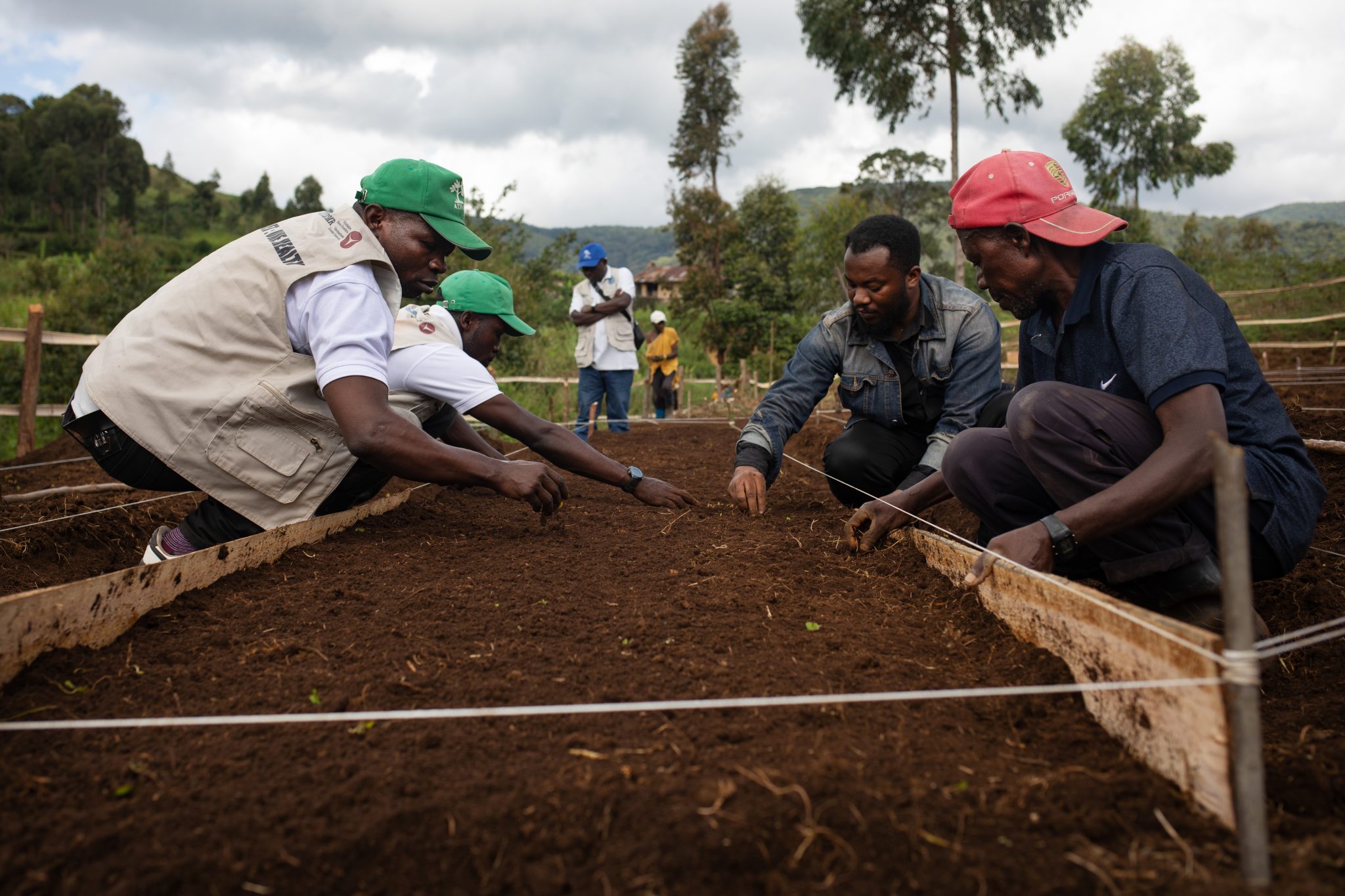
At the seed nursery in Bulolo, the Action pour le Développement des Milieux Ruraux team is preparing the soil for planting trees. Later, the seedlings will be distributed to local residents to plant and exploit their own forests outside the park. © Thomas Cytrynowicz
Until recently, Adolphe Nachibazibazi, aged 78, also used to go into the park to find firewood for his family. “I knew it was illegal and that we risked being arrested by the police, but we had no choice”, he said. You can see the edge of the park, bordered by bare hillsides, from his plot in Bulolo in the Kahungu health zone.
To fight the scourge of deforestation, Action pour le Développement des Milieux Ruraux has set up seed nurseries. Fast-growing species are cultivated there, and the seedlings are then distributed to local residents free of charge. “The idea is for the population to have their own ‘forests’ that they can use for firewood and charcoal, without having to go into the park”, says Papy Bagalewa Bahati, the coordinator of the One Health project for the association.
Among the species chosen by Adolphe and his son are Grevillea robusta trees for construction, Maesopsis eminii for its medicinal bark, and Calliandra, Agenia and Acacia mearci to make charcoal. Although it is still difficult today to imagine a forest on this almost bare hillside, that is exactly what is expected five years from now.
While waiting for these trees to mature, it is still tempting to exploit the park’s vegetation. So the project offers other alternatives to help the population meet their needs without having to draw on resources from the park. For example, Vétérinaires Sans Frontières Belgium is going to distribute goats to the most vulnerable families. These animals have several benefits in terms of diversifying people’s diets and fighting underlying malnutrition: goat’s milk is rich in protein, and the manure the animals produce makes harvests more abundant, so that surpluses can be sold to buy other food. To ensure that livestock farming is productive and healthy, our support is also accompanied by training in livestock-keeping techniques, awareness of zoonoses and animal health care.
Finding solutions in alignment with the communities’ reality
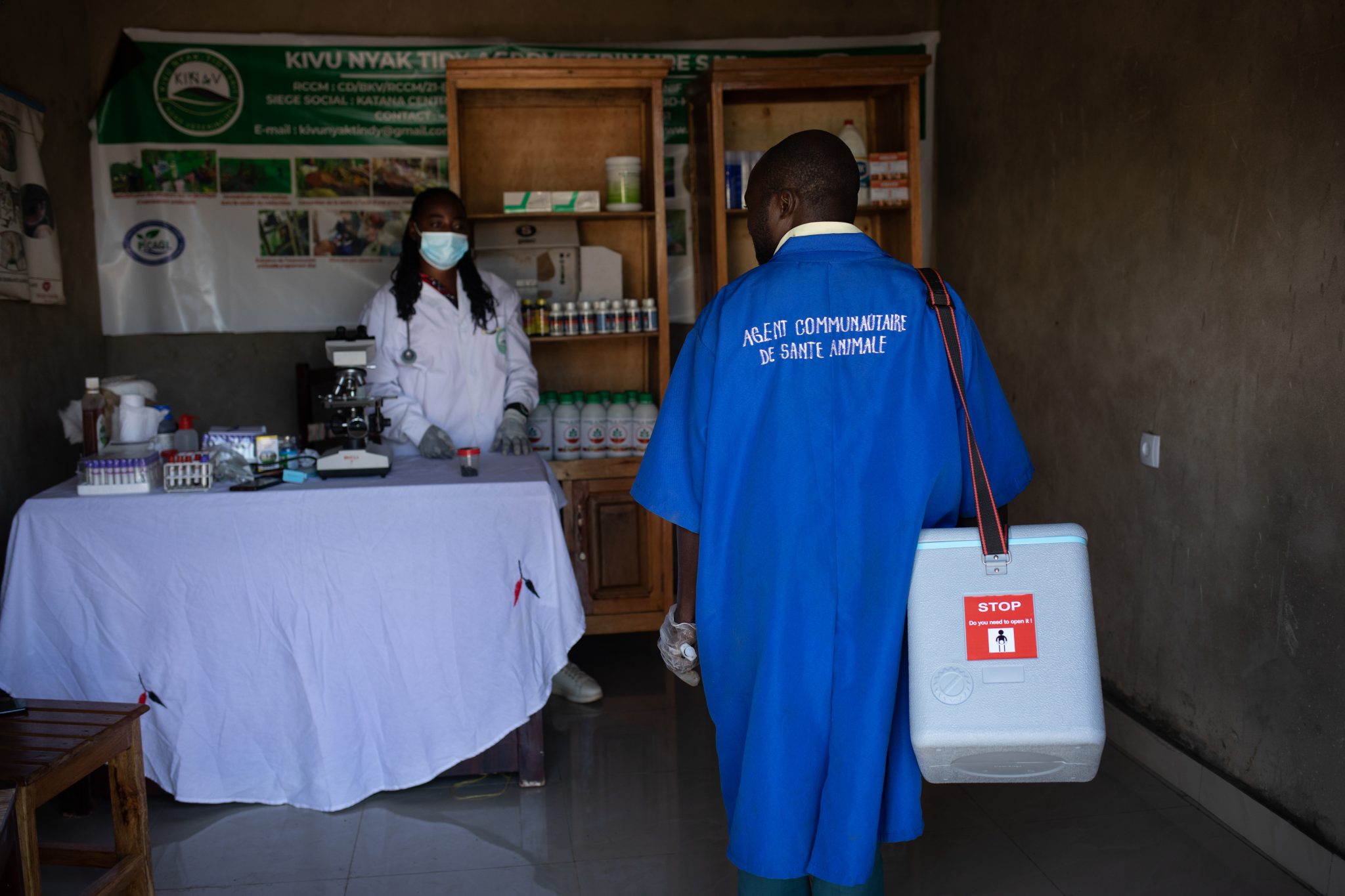
An animal health worker brings samples to Dr Safi Ngomora’s veterinary practice in Katana. Thanks to the One Health project, the vet has a microscope that enables her to diagnose diseases more quickly. © Thomas Cytrynowicz
Reforestation and reintroducing livestock are just two of the many facets of the One Health project, which began in May 2022 and will run for a period of five years. One of the project’s key components is also to strengthen health systems and work to break down compartmentalised thinking. This is an essential step towards improving the prevention, detection and management of health risks. In terms of animal health, Vétérinaires Sans Frontières Belgium has already started to strengthen its local network. Four vets have received laboratory equipment so that they can detect livestock diseases better before they are transmitted to humans. The 172 animal health workers active in the region have also been made aware of the One Health approach. Some have joined the One Health committees and, as such, are actively participating in epidemiological surveillance.
But for the project to be a genuine success, it will above all be necessary to change people’s mentalities. The challenge is daunting as traditional beliefs are tenacious. To achieve it, the project relies on “participatory action research”, supervised by Médecins du Monde. This concept involves listening to communities and health professionals in order to find solutions together that are adapted to reality in these communities. The survey carried out in Busandwe and twelve other villages is an integral part of this process.
Change is underway
In the small village church, the feedback session is drawing to a close. Soon, all the committee members will be trained in the One Health approach, ways of keeping zoonoses at bay and signs of zoonotic diseases. They will also learn a few communication techniques, which will come in very handy in their role of raising awareness among their families and neighbours. From now on, they will meet up every week to share their findings and, if necessary, issue health alerts through the nurse in charge of their health zone. Their reports will be systematically reported to the relevant veterinary and environmental authorities.
For now, most of the participants seem to have got the message. “I need to avoid contact between animals and us humans in the home”, says Pascasie. “I’m going to make an effort to find ways of preventing disease, which means changing the building where I keep my goats and permanently reducing their contact with us. I’ll try, but it won’t be easy.” While there is still a long way to go, change is well underway. Everyone is determined to move forward together in the right direction.
 This project is being carried out with the support of Belgian development cooperation. It is an unprecedented pilot experiment implemented by Vétérinaires Sans Frontières, Médecins du Monde and local partner Action pour le Développement des Milieux Ruraux. Each NGO specialises in one of the three health sectors: animal, human or environmental.
This project is being carried out with the support of Belgian development cooperation. It is an unprecedented pilot experiment implemented by Vétérinaires Sans Frontières, Médecins du Monde and local partner Action pour le Développement des Milieux Ruraux. Each NGO specialises in one of the three health sectors: animal, human or environmental.

